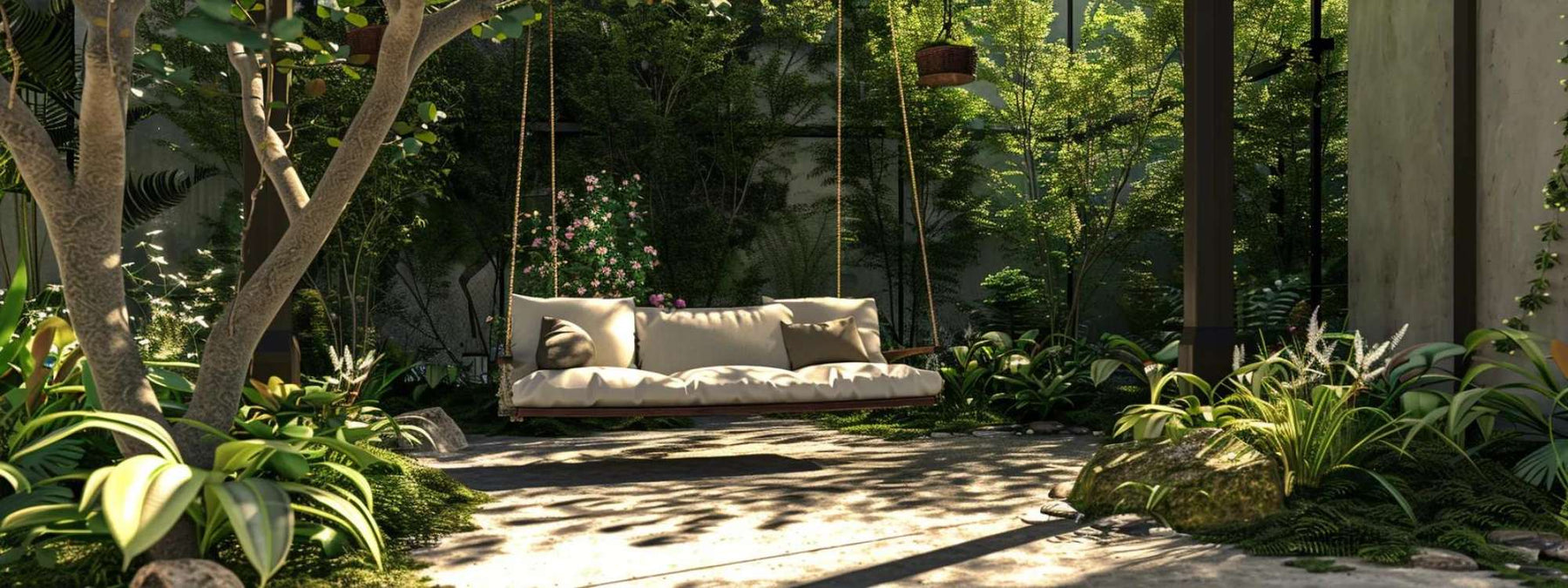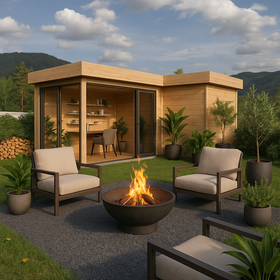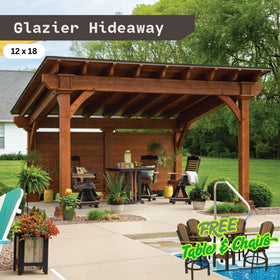512-777-0154

4 Steps to Create a Relaxing Garden With Outdoor Patio Swings
Some people need total silence. Others feel calm the moment they hear leaves rustling or a bird chirping in the distance, or a splash of water in their swimming pool.
For most of us, it’s not one thing. It’s a few small ones working together. Soft light. A bit of shade. Somewhere to sit that doesn’t feel like you’re about to get up again in two minutes. That’s the kind of space that gives your brain the green light to slow down.
And if you’re building that relaxing space outside, a patio swing is an easy place to start. It moves. It grounds you. It gives you a reason to pause.
But getting that relaxing garden vibe isn’t about the swing alone. It’s about what’s around it, how it fits your life, and whether you actually use it.
Step 1: Choose the Right Spot

Not every corner is suited for relaxation. You need a backyard living space that already feels a little quiet. Or at least not chaotic. This could be a shaded corner of your backyard, a small patch under your Structureworks Trex Pergola, or even a balcony that catches the late afternoon light.
Don’t overthink the size. This isn’t about building an outdoor living room. You just need a spot that gives you room to breathe.
Look for a level area where your LuxCraft 4′ Adirondack Swing won’t wobble. If you’re going for a hanging chair or hammock, make sure there’s a solid beam, branch, or frame to hold the weight.
Now think about the view. Not a dramatic view. Just something you won’t mind staring at for a while. A plant bed. A tree. Some landscape lighting. Even an outdoor fireplace or a small water feature can help set the tone.
If the living spaces outdoor get a lot of sun, add a canopy or position your swing under part of the roofline. Bonus points if there’s a ceiling fan nearby to keep the air moving.
Got privacy? Great. If not, tall plants or a wood fence can block distractions without boxing you in.
The swing doesn’t have to match the rest of your garden furniture perfectly, but it should feel like it belongs. Wicker. Wood. Cushions that don’t fight the mood.
Relaxing design is less about furniture, more about feel. The goal here is simple: choose a space that makes you want to stay put.
Related: 15 Outdoor Activities for Summer to Boost Mental Health
Step 2: Pick a Swing that Fits You
There are a lot of swings out there. Some look great online. Others feel good once you sit down. The goal is to find one that does both.
Here’s how to narrow it down before you start your home improvement project:
- Start with size. Are you swinging solo? Or do you want room for two? A porch bench or glider is great for sharing. A chair hammock works well if you’re going for quiet time alone.
- Think about style. Rustic wood. Sleek metal. A polywood swing with clean lines. A rattan seat that fits into your lawn or gazebo. If it clashes with your deck or balcony, you probably won’t love it for long.
- Decide on the setup. Hanging from the ceiling like LuxCraft 5′ Plain Swing? Freestanding steel frame? Attached to a pergola? Not all homes are swing-ready. If your porch can’t handle it, go with a frame or bench swing instead.
- Don’t forget comfort. Upholstery matters. Some cushions look soft but aren’t made for outdoor sunrooms or changing weather. Look for options with support, durable fabric, and colors that suit your outdoor living spaces. A chair that looks cozy but feels stiff won’t get much use.
- Match it to your space, not just your feed. A modern swing might look great on Instagram but feel out of place on a quiet porch. That oversized porch bench might look inviting until it takes over your entire balcony. Choose what fits your life, not someone else's design board.
Step 3: Add Calming Details
A patio swing chair by itself is a good start. But the space around it matters just as much. You don’t need much. Just a few thoughtful details to make it feel like a real outdoor sitting area.
Use plants to soften the space
Plants don’t have to be high-maintenance to be calming. Go for simple options like ferns, lavender, or snake plants. They work whether your LuxCraft 4′ Classic Swing is on the porch, next to the balcony railing, or tucked into the garden.
Taller plants can add a little privacy if your swing faces the fence or street. Climbing vines can soften the edges of a metal patio swing set. Potted herbs can even double as greenery and outdoor dining inspiration.
Bring in gentle sounds
Noise can kill the mood fast. If your garden swing chair is near traffic or a busy street, add a few things to help cut the background buzz.
Wind chimes are an easy fix. So is a small water fountain. Even plants like bamboo or ornamental grasses can help by rustling in the breeze.
The goal isn’t total silence. Just a bit of sound that feels better than the alternative.
Use soft lighting

A relaxing space should work after sunset, too.
Solar lanterns, low landscape lighting, or a string of warm white lights can go a long way. Skip the bright stuff.
If your swing is under a ceiling or attached to a Brookside Timber Frame Shadelan Retreat Pergola, subtle lighting up top works well, too. Same goes for a ceiling fan with a built-in dimmer.
Add small comforts
A throw blanket on the back of the garden swing seat. A small coffee table for your drink. A candle or two. These are the things that make it feel like part of your outdoor living spaces. Not just something you bought and forgot about.
Think about how you decorate a living room. Then take 10 percent of that effort and put it outside.
Step 4: Use Your Swing
Setting up a relaxing outdoor space is one thing. Actually using it is another.
A lot of swings end up looking nice but staying empty. Life gets busy. Days blur together. You walk past the LuxCraft 5′ Classic Swing on your porch bench and think, “Maybe later.”
The fix? Tie it to something you already do.
- Sit outside with your morning coffee.
- Read a few pages instead of scrolling your phone.
- Step away from your desk and reset on the glider.
- End the day in your outdoor space, even if it’s just ten minutes.
These aren’t big changes. But they make a difference. Relaxing isn’t a design project. It’s a habit.
Whether your swing is on a teak balcony, under a roof, or part of a larger patio living setup, the point is to use it. Same goes for swings near an umbrella-shaded coffee table or a tucked-away corner of your outdoor entertaining space.
If it helps, treat your garden swing like you would a spot inside your home. Think living room, but outside. Add small things that make it easy to stay, shade from an umbrella, a side table for drinks, maybe a LuxCraft 19" Throw Pillow that doesn’t slide off every time you sit down.
You built this outdoor living area for a reason. Don’t forget to enjoy it. Even if it’s just for a short break.

Let Your Garden Grow into Something You Love
Relaxing doesn’t show up just because you bought the right outdoor furniture. It takes time. So does shaping a space that feels like yours.
Start with a simple hanging swing. Add a plant. Drop in a small glider or a soft cushion with durable upholstery. Use what you have, build from there. A pergola, gazebo, or shaded lawn area might sound ideal. But if all you’ve got is a corner with good light, that’s still a solid place to begin.
The key is showing up for it. Even a few minutes a day. You’ll slowly start to use the space more without thinking about it. That’s when it shifts from “nice setup” to “this is where I go to reset.”
And if you're not sure what to add next or what to skip—we’ve got more outdoor living guides that break it all down.






